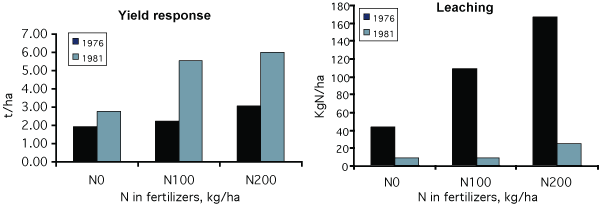


 |  |  | 3.2 Loss processes and governing factors |
The efficient management and control of N and P losses from diffuse agricultural sources requires understanding of the fundamental loss processes. The loss processes and mechanisms are slightly different for N and P. Basically, however, the processes can be divided in three main categories
Generally, climate, topography and soil types in addition to farming systems and practices are the most important governing factors influencing the magnitude and the variability in losses, and to a large degree determining the hydrological pathways by which nutrients are transported.
N losses are mainly the result of leaching processes with surface runoff rarely being a significant pathway. The prerequisites for leaching of N are:
How much of the N that finally reaches the surface water depends to a large degree on the fate of the N after it is leached from the root zone of the soil. At intensively drained soils a large part of the leached N will presumably be transported directly to the surface water through the subsurface drainage system. However, on more coarse textured soils, a large part of N may also be transported downwards to the ground water and reach the surface water at a later stage, depending on the residence time. In the latter case, significant reduction of nitrate due to denitrification processes may occur. Investigations in Denmark indicated that only around 10% of the nitrate lost from the root zone on some sandy soil catchments reached the surface water, whereas more than 50% in clay soil catchments [196].
Often a close link is suggested to exist between fertiliser application levels and N losses, and consequently also that reduction in losses thereby can be obtained by a reduction in the N applications. An overall impression exists that the major cause of N-losses from agricultural is the fertiliser use. However, several studies have indicated that N losses first of all depend on transformation processes related to soil organic matter, and that N application levels when being within the limits of yield response, only moderately affects the losses. Norwegian studies [296] using labelled N (15N) revealed that roughly 2-10% of the leached N derived from pre-season applied fertiliser, whereas the main part originated from mineralization of soil organic N. These findings are in agreement with results from studies in other countries. On the other hand, it is a well known fact that N applications, when exceeding crop nutrient requirements may result in substantial leaching losses. Figure 1, based on field lysimeter experiments in Norway, illustrates clearly the relations between yield response and leaching of N. One dry year (1976) with minor yield response to applied N resulted in much larger leaching losses compared to a year with normal yield response (1981).

Poorly drained soils, long residence times for water in catchment areas, and high soil pH will contribute to increased gaseous losses, and thereby reducing N losses to the open water courses. The hydrological properties of soils and catchments are, indirectly, of great importance for the potential buffering of N leaching.
The phosphorus loss processes are in principle quite different from the N processes, and depend less on biological soil processes. The P adsorbtion capacity of most soils is very high, usually resulting in moderate leaching of P. The exceptions are coarse textured sandy soils or peat soils with low contents of Al, Fe or Ca. Soil erosion is usually a major source of P losses from agricultural land. P containing soil particles may be transported both by surface runoff, and by percolating water through macro-pores, cracks and finally through the tile drain systems reach the open water courses. In regions with a cold winter climate, P containing plant residues at the soil surface may also pose a risk for substantial P losses by surface runoff during melting periods. Also manure or slurry applications may result in direct losses either as surface runoff or through the soil matrix, cracks and/or macro-pores. As for the plant residue losses, this will be P forms with rather high bio-availability. Very high P losses have, for example, been measured in areas with long-term applications of large amounts of pig manure in Latvia [476]
 |  |  | 3.2 Loss processes and governing factors |